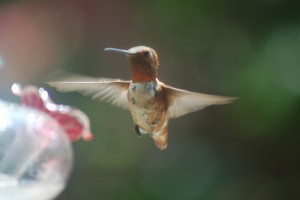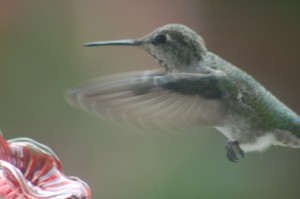
Photo credit: Bobbie Hedges
The last thing I expected to see while walking into my yoga class was a hummingbird. Even though hummingbirds are so tiny, she stuck out like a sore thumb perched on a bright-yellow pipe running along an equally bright yellow-brick wall.
It was thrilling to see a hummingbird so close, but terrible as soon as I realized her predicament. She was scared out of her wits, flying furiously as soon as anyone approached, slamming her delicate little body into the ceiling trying to escape. My yoga mates and I realized it was best to leave her alone and hope she would fly towards the open door and freedom on her own; otherwise she might physically harm herself trying to flee from us.
I couldn’t take my eyes off of her. So petite and perfectly sculpted, who are these creatures?
Hummingbirds are part of the family Trochilidae and are only found in the Americas, mesmerizing the first Europeans to cross the Atlantic having never seen them before, according to Donald and Lillian Stokes, authors of Beginner’s Guide to Hummingbirds.
The Sibley Guide to Bird Life & Behavior states there are more than 300 species of hummingbirds, but only 18 live in or fly about North America. In the South Bay, there are many opportunities to glimpse hummingbirds, but the most common are the Allen’s and the Anna’s.
To identify hummingbirds, it’s best to have a guidebook and amazing vision. But there are distinguishing characteristics to look for that will make identification a bit easier.
Dan Cooper, President of Cooper Ecological Monitoring, Inc. and local bird expert who wrote the book Important Bird Areas of California, gives the following advice on how to best distinguish the two most common hummingbirds.
“Note that both Allen’s and Anna’s come in two plumages each, with females lacking the bright shiny gorget, the reflective feathers on the throat and forehead,” said Cooper. “People report gray hummingbirds a lot, which are female Anna’s. And as a tip, if you see orange on a hummingbird, assume it’s an Allen’s.”
But things have changed locally in the last 20 years. Anna’s used to be the most common hummingbird, but now the Allen’s are the most common in the South Bay after expanding their empire from beyond the Palos Verdes Peninsula.
This trend is thanks to the influence of humans.
According to Cooper, “As for the expansion of Allen’s, it’s a couple factors, the popularity of Cape honeysuckle and red-flowering eucalyptus in landscaping, as well as intrinsic biological factors involving the birds [Allen’s], like their pugnacious nature, dominance around Anna’s and ability to exploit, not adapt to, but actually take advantage of and expand their range while using non-native vegetation. “So, in effect, their abundance is a ‘bad sign’ ecologically, since it shows that we’ve messed up our native ecosystem so this thing can thrive.”
Since hummingbirds are so cool, it’s a bummer to think that Allen’s are actually another red flag, or orange flag if we stick to their coloring, indicating thanks to us the natural order is out of whack.
But regardless, seeing a hummingbird is breathtaking.
Identification is easier on a bright sunny day because if the angle is right the light will reflect off a hummingbird’s gorget and then you know it’s a male. If that flash of light and color is orange, it’s an Allen’s and if it’s red then it’s an Anna’s. The gorget on a full-grown male Anna’s covers the entire head like a shiny red face-mask, while a full-grown Allen’s has shiny feathers just on the throat area like a bright orange beard. And if you don’t see color, then it’s a female. As Dan describes, grayish coloring indicates an Anna’s and a dull orange-brown is most likely an Allen’s.
Weighing in at only .1 to .3 ounces, hummingbirds could be mailed with a 44 cent stamp; that is if you could ever catch one, which you shouldn’t because they are protected, not to mention aggressive. Hummingbirds have been observed defending their territories and nests against animals several times their size.
Despite their petite looks and delicate mannerisms, hummingbirds view sex as strictly business. This means that males stake out areas considered to be good pick-up locations for meeting ladies and once business is complete females fly off to areas suited for nesting and each defends their separate territories.
These mini birds fly up to 45 miles per hour (the Sibley Guide says up to 60 miles per hour!) and their wings beat up to 78 times per second according to Donald and Lillian Stokes. It’s Superbird!
But what do hummingbirds eat to sustain this level of activity? Every child’s dream diet—sugar.
Hummingbirds are perfectly adapted for feeding on flowers, sticking in their beaks and sometimes their heads to gather nectar. Since their beak is shaped like a miniscule straw, it’s easy to imagine them sucking up nectar delights like sugar crazed people do with a milkshake. But hummingbirds don’t suck nectar, they lick it.
Having the fastest tongues in the west, they furiously lick nectar with a long slender tongue that extends far beyond their beaks. The tongue actually has grooves along each side that act like gutters allowing nectar to flow down their throats with grace and ease.
But don’t get too jealous of a hummingbird’s sugary nutrition plan, they still have to fulfill their version of the Atkins diet by getting protein from bugs including fruit flies, gnats, mosquitoes, maggots and spiders, just to name a few.
After chirping away in a high pitched voice throughout the yoga class, the hummingbird collapsed from exhaustion to the floor. A classmate used a cloth to gently pick her up and place her outside in a leafy area where she could recover. I say “her” because I’m pretty sure the hummingbird was a female Anna’s, mostly greenish-gray without any distinctive coloring. Her tiny eyes blinked at us in fear. But later she took off, a superbird once again, and is hopefully back to enjoying bugs or a sugary snack from a flower.

Nice introductory article to Hummers. These are truly amazing birds and a wonder of mother nature. Can’t get enough of these little ‘jet fighter’ gems. They always offer me a challenge when I photograph them.
http://MichaelDanielHo.com/anna35.jpg